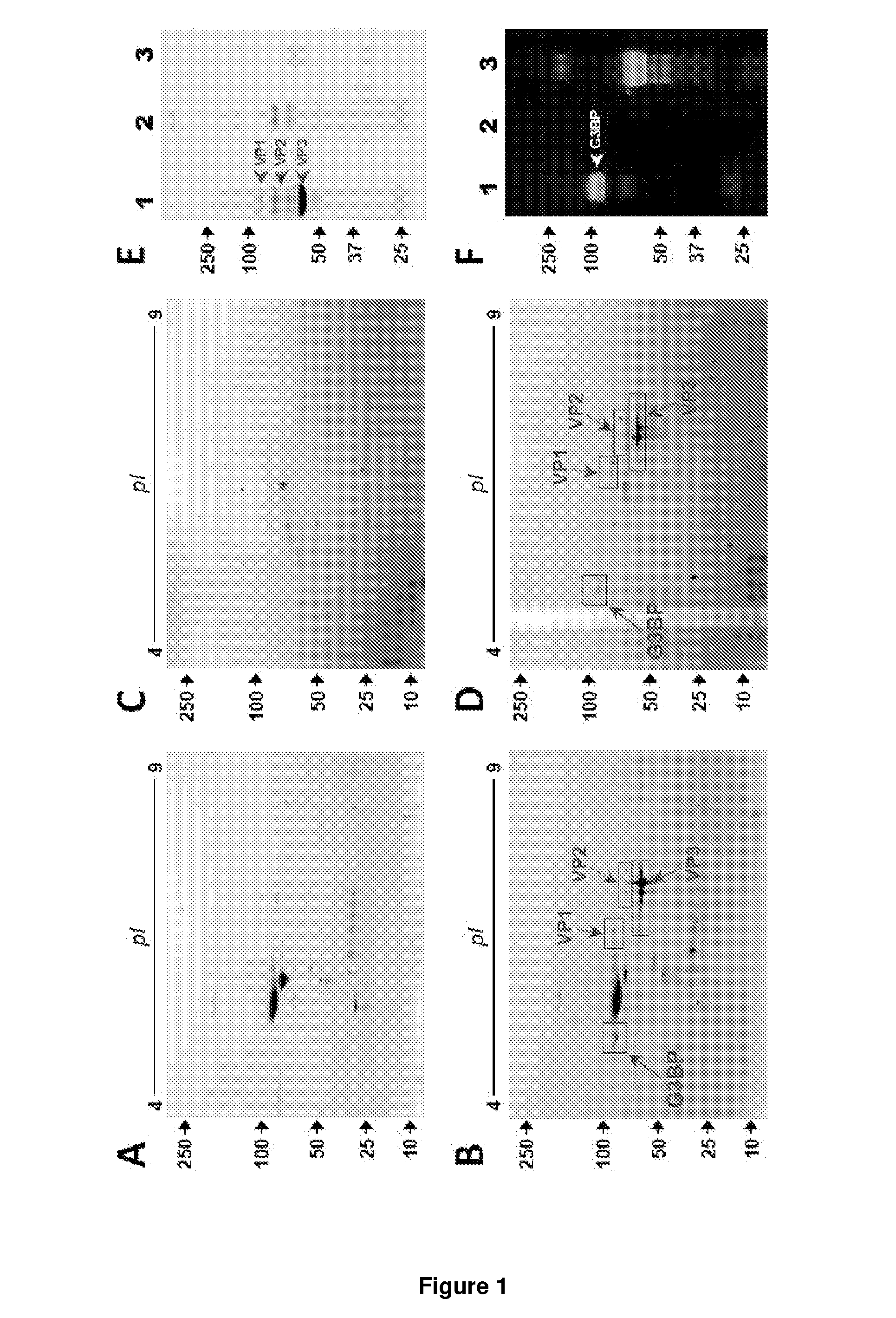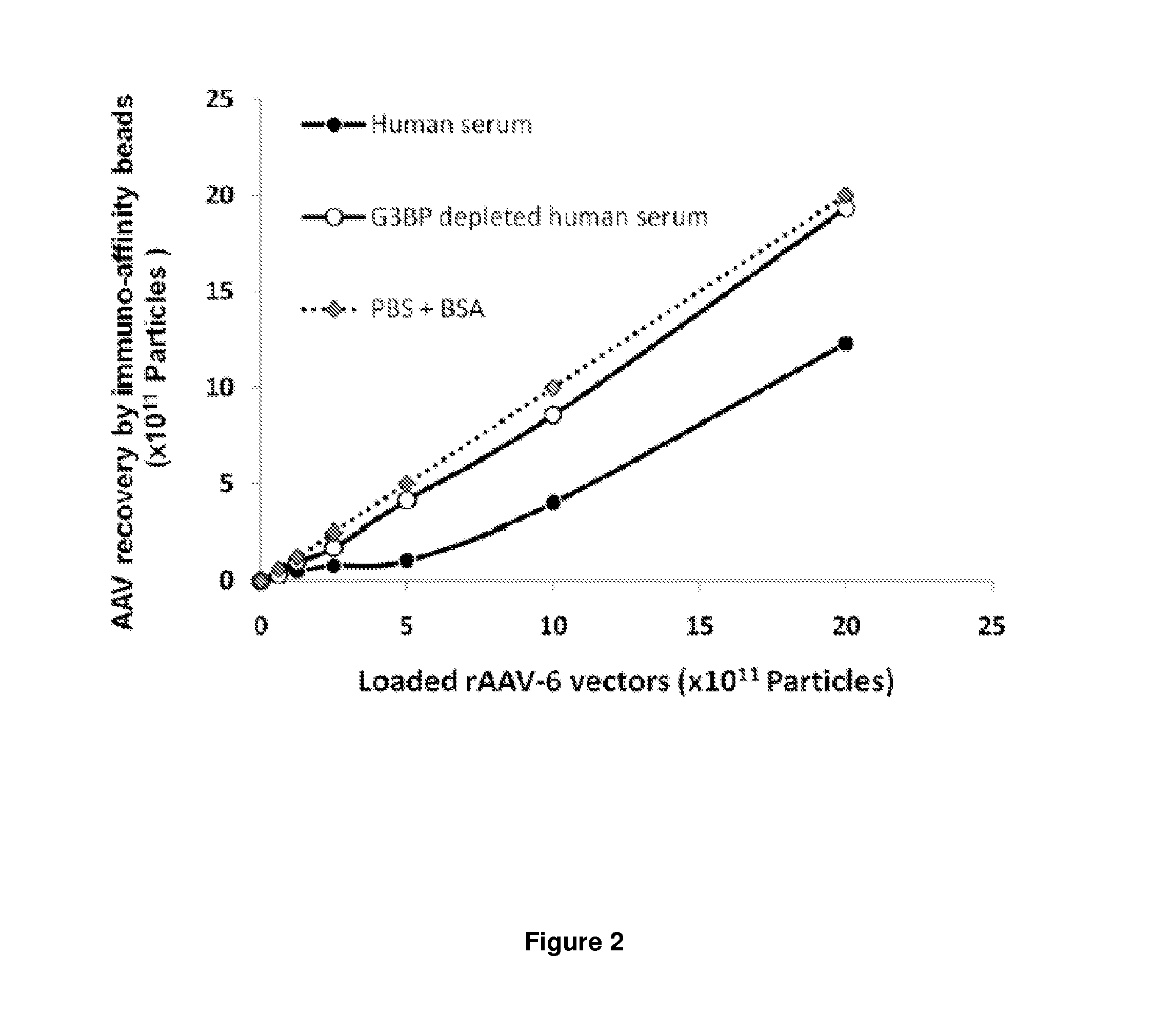Methods of increasing efficiency of vector penetration of target tissue
a vector and target tissue technology, applied in the direction of immunoglobulins, peptides, drugs against animals/humans, etc., can solve the problems of limiting the efficacy of vectors, hiv infection, and immunocompromised individuals, and achieve the effect of reducing the ability of virus
- Summary
- Abstract
- Description
- Claims
- Application Information
AI Technical Summary
Benefits of technology
Problems solved by technology
Method used
Image
Examples
example 1
rAAV-6 Interacts with G3BP in Human and Dog Sera
[0139]We screened for proteins interacting with rAAV vectors in serum samples from different species. Proteins interacting with rAAV-6 were first assessed in AAV6-seronegative dog sera by using co-sedimentation assays and 2D gel analysis. In a reproducible manner, multiple spots with similar molecular weights (about 90 kD) and isoelectric points (5.0-5.2) were exclusively found in rAAV-6 driven precipitates (FIG. 1A, B). Mass spectrometry analysis identified these spots as galectin-3 binding protein (G3BP), a highly glycosylated glycoprotein enclosing a scavenger domain. We next aimed to confirm this finding in human serum. Here, proteins interacting with vectors were recovered via rAAV-6 immobilized on immuno-affinity AVB-Sepharose beads, which improved sensitivity and reduced non-specific hits. Consistent with previous experiments using dog sera, 2D gels of recovered material exhibited multiple spots with an apparent MW of 90 kD and ...
example 2
Human G3BP Hampers rAAV-6 Recovery by Immunoaffinity Beads
[0142]To determine whether hu-G3BP altered the binding of rAAV-6 to AVB-Sepharose beads, vectors were pre-incubated with either PBS supplemented with BSA, or human serum, or human serum depleted of G3BP by pre-incubation with immobilized anti-G3BP antibodies. Recovery of rAAV-6 in the PBS condition was linearly proportional to the concentration of physical vector particles (FIG. 2). In contrast, vector recovery in the presence of serum was compromised up to 8×10E11 physical particles (pp) / ml of vector, although it gradually increased and became parallel to the recuperation curve in PBS for high vector concentrations. Markedly, when serum was depleted of G3BP, rAAV-6 recovery was similar to the PBS condition, indicating that G3BP binding to rAAV-6 compromised either its affinity for AVB-Sepharose beads or altered its dispersion properties lowering the vector's access to beads.
[0143]Legend of FIG. 2. Human G3BP Hampers rAAV-6 R...
example 3
Human G3BP Interacts Differentially with the Various rAAV Serotypes
[0145]In order to anticipate the most appropriate rAAV for clinical use under systemic delivery conditions, we investigated putative interactions of several serotypes (-1, -2, -2i8, -5, -6, -7, -8, -9 and -10) with G3BP in respective human seronegative sera. In these experiments, human sera were incubated with immobilized rAAVs, and Hu-G3BP recovery was appraised by Western blot analysis. In the case of rAAV-9, which does not bind AVB-sepharose beads, putative complexes were assessed by ultracentrifugation. Clearly, hu-G3BP was recovered in the presence of serotype-1, -5, -6 and -8, but not in presence of rAAV-2, -2i8, -7, -9 and -10 (FIG. 3 A). Binding affinities of rAAV-6, -8, -9 to hu-G3BP were further analyzed by using surface plasmon resonance imagery (SPRi) (FIG. 3 C). At all tested concentrations, rAAV-6 displayed the highest binding capacity to hu-G3BP while rAAV-9 did not show any binding. Interestingly, rAA...
PUM
| Property | Measurement | Unit |
|---|---|---|
| Efficiency | aaaaa | aaaaa |
| Time | aaaaa | aaaaa |
| Exposure limit | aaaaa | aaaaa |
Abstract
Description
Claims
Application Information
 Login to View More
Login to View More - R&D
- Intellectual Property
- Life Sciences
- Materials
- Tech Scout
- Unparalleled Data Quality
- Higher Quality Content
- 60% Fewer Hallucinations
Browse by: Latest US Patents, China's latest patents, Technical Efficacy Thesaurus, Application Domain, Technology Topic, Popular Technical Reports.
© 2025 PatSnap. All rights reserved.Legal|Privacy policy|Modern Slavery Act Transparency Statement|Sitemap|About US| Contact US: help@patsnap.com



